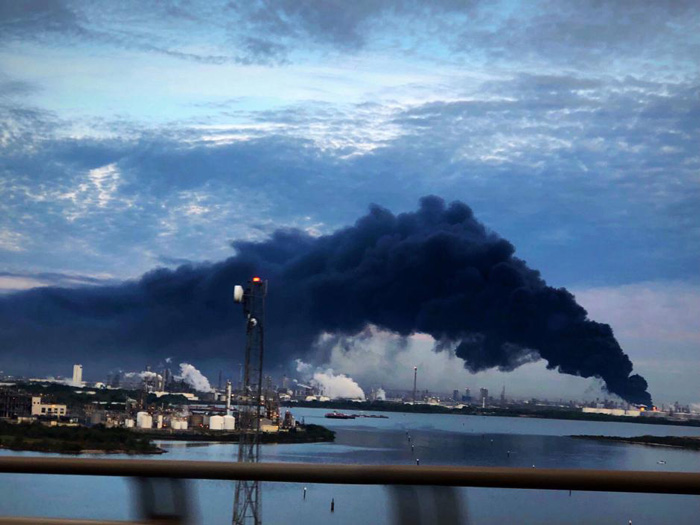
[Photo Source: Moms Clean Air Force]
It has been more than a week since the petrochemical storage tank fire started burning. As many Texans watched in horror the huge trail of black smoke stretch for miles (it reached the I-35 corridor and beyond), residents of Deer Park and surrounding areas had to deal with the very real danger of exposure to hazardous and toxic substances.
But it didn’t end after a three day burn. Last Friday, a containment barrier was breached around a damaged petrochemical tank, sending toxic chemicals into the bayou and then into the Houston Ship Channel. The facility also caught fire again.
It is difficult to grasp the scope of the disaster that has unfolded.
Health effects reported during ITC disaster by Deer Park residents speaking on TV and information from residents include: nose bleeds, dizziness and light-headednes, headaches, and sleeping difficulty, among others.
Local health officials need to be transparent with the public about what is in the samples they have collected so far.
PFAS foams
As we shared on our Facebook and Twitter accounts, even the firefighting foam chemicals that emergency responders used to try to put out the blaze is toxic. According to the Houston Chronicle, 137,000 gallons of PFAS-containing fire fighting foams were used, and were running off into the Houston Ship Channel, with local toxicologists and fishers expressing concern for the health of communities and ecosystems connected to the Ship Channel.
PFAS-containing fire fighting foams have contaminated hundreds of waterways and drinking water systems across the U.S. The chemicals cannot be broken down, and persist indefinitely in the environment.
Benzene and other toxics
As to what chemicals might cause these health effects, it’s difficult to say, but the fire chemistry and smoke from burning pre-gasoline products would have been complex and contained unburned benzene, xylene, and toluene as listed by ITC in its STEERS (State of Texas Environmental Electronic Reporting System) reports to TCEQ.
Benzene was measured in the ambient air in Deer Park since the ITC fires could have released large concentrations of it, but officials largely emphasized that benzene levels were at safe levels (not credible since carcinogens have no safe level except zero parts per billion). New or “de novo” benzenes and other chemicals could have formed in the fire and smoke plume due to the extensive incomplete combustion.
Soot emissions of PM2.5 Fine Particulate Matter - 1997 EPA national standards
Soot particles or PM2.5 were measured at some sites. We don’t find it credible that officials reported PM2.5 at levels only below the federal 24-hour standard because all it takes is a tiny puff of smoke at ground level to exceed the EPA daily standard set at 35 micrograms/m3 for 24-hours adopted by EPA in 2013. The current 2013 EPA PM2.5 standard is set at an invisible, microscopic level of PM2.5 soot particles.
The formation of smoke and PAH chemicals are certainly not in the best interest of public health.
The U.S. Environmental Protection Agency (EPA) adopted a new soot or fine particle standard in 1997 due to the medical evidence that combustion particulate matter from burning fossil fuels is harmful to human health at relatively low levels. See EPA table here.
Current federal PM2.5 NAAQS is 35 micrograms/m3 for 24-hours, but CARB has a safer standard of 25 micrograms/m3. In Houston, officials have not clearly stated if PM2.5 soot levels reached above 35 micrograms/m3 for 24-hours, but fires are known to generate thousands of micrograms/m3 of PM2.5 particles.
Other carcinogenic chemicals created in fires and present in smoke particles
Polycyclic aromatic hydrocarbons (PAHs) are known in the smoke or soot emissions from fires. In other words, smoke is an indication that many PAHs are being formed and released into the ambient air. No Ultrafine particles were measured of one micron and less in size since there are no federal or state ambient air standards. Ultrafines can be measured with special filters, and fires and combustion devices are identified as large sources of ultra fine particles.
What can we do?
Stay vigilant. If you are concerned for your health, there are clinics you can go to. We will try to update this blog with details soon.
A number of different lawsuits have already been announced, including the Texas Attorney General (surprised?) and Harris County. But as so many people who live in the air and watershed of the petrochemical refinery complexes along our Gulf Coast know, this isn’t the first time something bad like this has happened and it won’t be the last until our elected leaders take pollution and public health seriously.
There is a good bill (SB 1446) by Sen. Nathan Johnson filed at the Texas Legislature that addresses above ground storage tank standards, but it focuses only on mitigating risk from flooding and high-wind events (like Harvey and the Trinity River floods of 2015). It also has yet to get a hearing in the Senate Committee on Water and Rural Affairs. There are also two good bills (SB 2175 by Sen. Borris Miles and SB 2065 by Sen. Jose Menendez) that address the so-called “affirmative defense” that polluters can use to skirt punitive measures when they screw up and release more pollution. Both have been referred to the Senate Committee on Natural Resources and Economic Development and have yet to receive a hearing.
Our hearts go out to the people suffering the most from this preventable disaster. We must show our elected leaders that we are angry and expect more of them. Polluting companies with bad track records who are allowed to continue to pollute should compel lawmakers to adopt more stringent regulations and enforcement. The people of Texas can’t continue to sacrifice their health for the refineries.
Stay tuned to our blog and social media channels for updates.